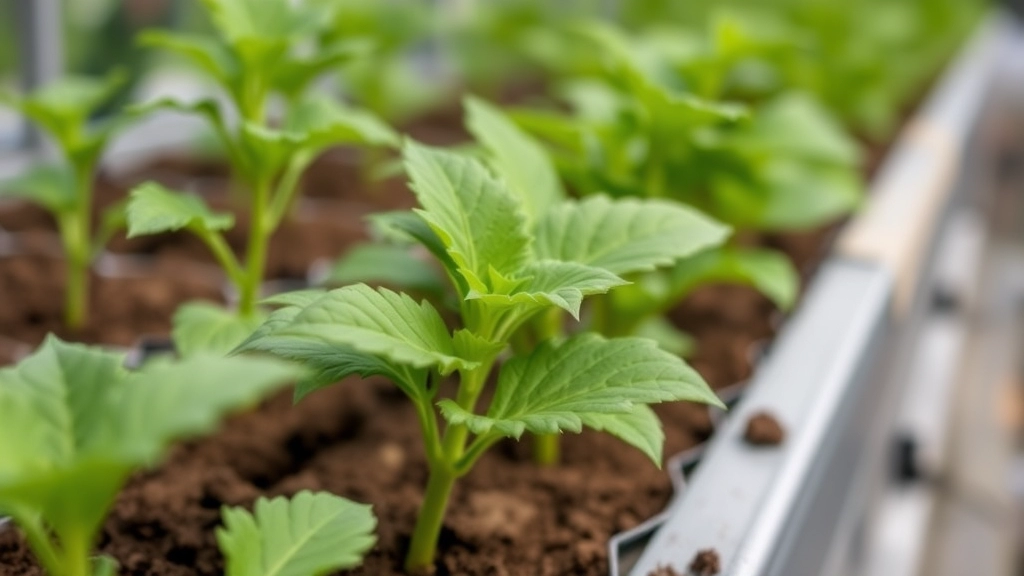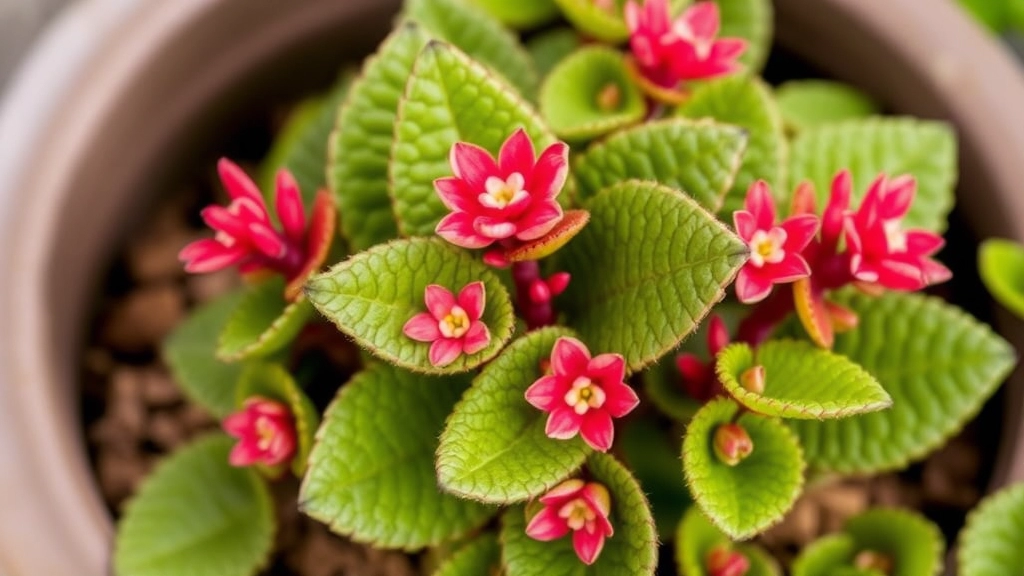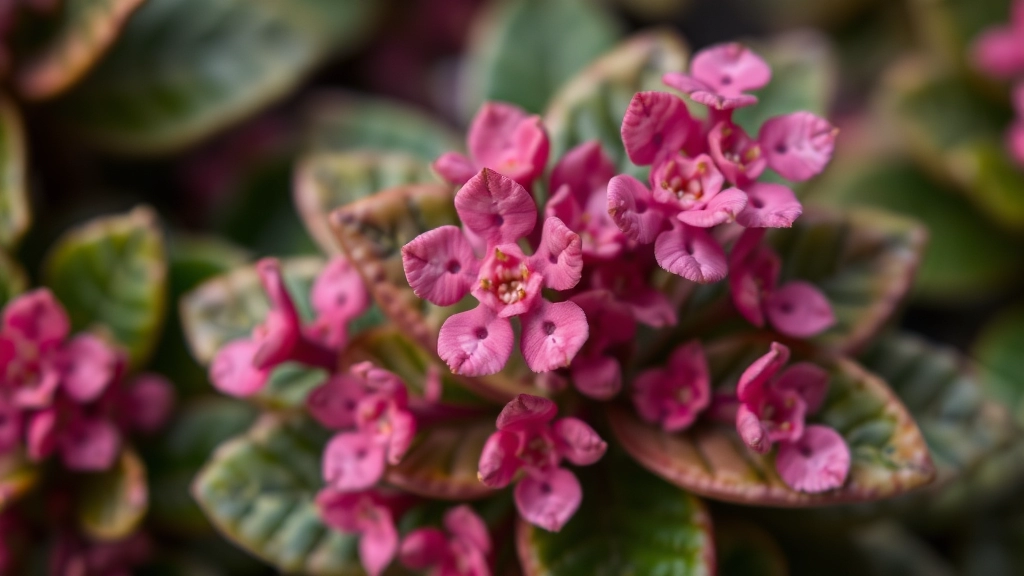Welcome to the world of Kalanchoe tomentosa chocolate
A succulent that’s as intriguing as it sounds! In this article, we’ll explore the unique characteristics of this velvety plant, from its fuzzy chocolate-brown leaves to its low-maintenance care requirements. Whether you’re a seasoned plant enthusiast or a curious beginner, you’ll discover why this charming succulent is stealing the spotlight in the plant world.
Get ready to dive into the ideal growing conditions, watering tips, and propagation techniques for Kalanchoe tomentosa chocolate. We’ll also discuss common pests and diseases to watch out for, and share creative ways to incorporate this stunning plant into your home decor. By the end, you’ll be equipped with all the knowledge you need to help your Kalanchoe thrive and add a touch of chocolatey charm to your space.
Characteristics of Kalanchoe Tomentosa Chocolate
Ever seen a plant that looks like it’s covered in fuzzy chocolate? That’s our star today.
Kalanchoe Tomentosa Chocolate is a real head-turner in the succulent world.
Picture this: velvety brown leaves that feel like touching a teddy bear.
But don’t let the cuddly look fool you – this plant’s tough as nails.
It’s got these thick, fleshy leaves that store water like a champ.
The edges? They’re lined with cute little notches, almost like it’s wearing a frilly collar.
And when it flowers? Get ready for a show of tiny, bell-shaped blooms.
But let’s be real – it’s the chocolatey leaves that steal the spotlight.
This plant’s a slow grower, so don’t expect it to take over your space overnight.
It’s perfect for folks who want a low-maintenance plant with high-impact looks.
Think of it as the strong, silent type of the plant world.
Kalanchoe Tomentosa Chocolate: the plant that looks good enough to eat (but don’t, seriously).
Ideal Growing Conditions

Alright, let’s chat about the perfect setup for your Kalanchoe Tomentosa Chocolate. Trust me, getting this right is like giving your plant a VIP pass to thrive-ville.
Light: The Sweet Spot
These fuzzy fellas love their sunshine, but not too much. Think of it like a beach day – you want that golden glow, not a sunburn. Here’s the deal:
- Bright, indirect light is the jackpot
- A few hours of morning sun? Perfect
- Afternoon sun? That’s a bit too spicy for these guys
I’ve got mine chilling near an east-facing window, and it’s living its best life.
Temperature: Keeping It Cozy
Kalanchoe Tomentosa Chocolate isn’t into extreme weather. It’s more of a Goldilocks plant – not too hot, not too cold. Here’s what you’re aiming for:
- Ideal range: 60-75°F (15-24°C)
- Can handle a bit cooler at night
- Anything below 50°F (10°C)? That’s a no-go
Soil: The Foundation of Success
Here’s where a lot of folks mess up. Your Kalanchoe needs soil that drains faster than your bank account on payday. Why? Because soggy roots are a one-way ticket to plant heaven.
- Use a well-draining cactus or succulent mix
- Or DIY it: regular potting soil + perlite or coarse sand
- Pro tip: Add some gravel at the bottom of the pot for extra drainage
Humidity: Not a Big Deal
Good news for those of us who can’t be bothered with humidifiers – these plants aren’t fussy about humidity. They’re like the low-maintenance friend in your plant squad.
- Average room humidity is fine
- No need for misting or pebble trays
- If your skin’s comfortable, your Kalanchoe probably is too
Pot Size: Snug as a Bug
Here’s a quirky fact – Kalanchoe Tomentosa Chocolate actually digs being a bit root-bound. It’s like they enjoy a snug hug from their pot.
- Choose a pot just slightly larger than the root ball
- Make sure it has drainage holes (non-negotiable!)
- Terracotta pots are great – they help wick away excess moisture
Remember, nailing these conditions is key to growing a happy, healthy Kalanchoe Tomentosa. Get these right, and you’re well on your way to plant parent stardom. Next up, we’ll dive into how to keep this beauty hydrated without drowning it. Stay tuned!
Watering and Maintenance Tips
Alright, let’s dive into watering and maintenance tips for Kalanchoe Tomentosa Chocolate.
Here’s the deal with these fuzzy succulents:
Watering: Less is more
- These guys are drought-tolerant champs.
- Overwatering? That’s their kryptonite.
- Water sparingly, only when the soil’s bone dry.
- In summer, maybe once a week.
- Winter? Cut back even more.
Soil: Well-draining is key
- Mix cactus soil with perlite or sand.
- You want that water to flow through, not hang around.
Light: Bright but indirect
- They love light, but direct sun can scorch ’em.
- A sunny windowsill with a sheer curtain? Perfect.
Pruning: Keep it tidy
- Snip off dead or yellowing leaves.
- It keeps your plant looking sharp and prevents disease.
Fertilizer: Go easy
- Feed during growing season with a diluted succulent fertilizer.
- Once a month is plenty.
Temperature: They’re not fussy
- Room temp is fine, but they can handle a bit of chill.
- Just keep ’em above 10°C (50°F).
Humidity: They’re not big fans
- Average room humidity works.
- No need for misting or humidifiers here.
Remember, Kalanchoe Tomentosa Chocolate is a low-maintenance plant.
The biggest risk? Loving it too much with overwatering.
When in doubt, err on the dry side.
Your Chocolate Soldier will thank you for it.
Common Pests and Diseases
Hey there, fellow plant lovers! Let’s chat about the not-so-fun part of growing Kalanchoe Tomentosa Chocolate – the pesky pests and annoying diseases that can crash our plant party. Trust me, I’ve been there, and it’s no picnic. But don’t worry, I’ve got your back!
Unwanted Guests: The Pest Problem
First up, let’s talk bugs. These little critters can be a real pain in the… leaves.
- Mealybugs: These fuzzy white pests love to cozy up in the nooks and crannies of your Kalanchoe. They’re like that annoying houseguest who overstays their welcome.
- Spider Mites: Tiny but mighty, these guys can cause some serious damage if left unchecked. Keep an eye out for fine webbing on your plant – it’s their calling card.
- Aphids: Small, green, and always hungry, aphids can suck the life out of your plant faster than you can say “Kalanchoe”.
Pro Tip: A quick blast of water can often dislodge these pests. For tougher cases, I swear by neem oil – it’s like kryptonite for bugs!
The Disease Dilemma
Now, let’s talk about diseases. They’re sneaky, they’re silent, and they can turn your beautiful Kalanchoe into a sad, droopy mess.
- Root Rot: This is the big bad wolf of Kalanchoe diseases. It’s usually caused by overwatering – a mistake I’ve made more times than I’d like to admit.
- Powdery Mildew: This white, powdery stuff can cover your plant’s leaves faster than you can say “fungus”. It thrives in humid conditions, so keep that air flowing!
- Leaf Spot: Brown or black spots on the leaves? Yep, that’s leaf spot. It’s like acne for plants, and just as annoying.
Here’s the deal: prevention is key. Keep your Kalanchoe Tomentosa Chocolate in well-draining soil, don’t overwater, and make sure it’s got good air circulation. It’s like giving your plant a health insurance policy!
Remember, a healthy Kalanchoe is a happy Kalanchoe. Keep an eye on your plant, act fast if you spot any issues, and you’ll be golden. And hey, if all else fails, there’s always propagation to start fresh. But that’s a story for another day!
So, are you ready to tackle those pests and diseases head-on? Your Kalanchoe Tomentosa is counting on you!
Propagation Techniques
Let’s talk about how to make more of these fuzzy little succulents.
Kalanchoe Tomentosa Chocolate is a breeze to propagate. Trust me, I’ve done it loads.
Here’s the deal:
Leaf Cuttings:
- Snip a healthy leaf
- Let it dry for a day or two
- Pop it on some well-draining soil
- Mist occasionally
- Watch for roots in a few weeks
Stem Cuttings:
- Cut a 4-inch stem
- Remove lower leaves
- Let it callous over
- Stick it in soil
- Keep it slightly moist
Division:
- Gently separate offshoots from the main plant
- Ensure each has roots
- Replant in fresh soil
Pro tip: Spring or summer’s the best time for this. The plant’s in growth mode then.
Remember, patience is key. These guys aren’t speed demons.
I once propagated a whole bunch for a mate’s wedding favours. Went down a treat!
Kalanchoe Tomentosa Chocolate propagation is a fun way to expand your collection or share with friends.
Benefits of Growing Kalanchoe Tomentosa Chocolate

Let’s chat about why you might want to add Kalanchoe Tomentosa Chocolate to your plant family. Trust me, this fuzzy little succulent’s got more going for it than just its cute looks!
Air Purification Powerhouse
First off, this plant’s not just sitting pretty. It’s working hard to clean your air. Like its succulent cousins, Kalanchoe Tomentosa Chocolate is a champ at soaking up toxins from the air. It’s like having a natural air purifier that doesn’t need batteries!
Stress-Busting Beauty
Ever had one of those days where everything’s going wrong? Well, having this chocolate-coloured beauty around can help:
- Its fuzzy leaves are oddly satisfying to touch
- The rich, dark colour is soothing to look at
- Caring for it can be a calming, mindful activity
Low-Maintenance Mate
Look, we’re all busy. Who’s got time for high-maintenance plants? That’s where Kalanchoe Tomentosa Chocolate shines:
- It’s drought-tolerant (perfect for forgetful waterers!)
- Doesn’t need much fertiliser
- Can thrive in various light conditions
Decorative Dynamo
This plant’s a real showstopper. Its unique chocolate-brown leaves with silver edges make it stand out from the crowd. It’s like having a living piece of art in your home!
Propagation Potential
Here’s a fun fact: you can easily grow more of these beauties from leaf cuttings. It’s like getting free plants! Plus, they make great gifts for your plant-loving mates. If you’re interested in learning more, check out our guide on how to propagate Kalanchoe tomentosa.
Year-Round Appeal
Unlike some plants that only look good for a season, Kalanchoe Tomentosa Chocolate keeps its charm all year long. No flowers needed â its foliage is the star of the show.
So, there you have it. Kalanchoe Tomentosa Chocolate isn’t just a pretty face. It’s a hard-working, stress-busting, air-cleaning machine that looks good doing it. And the best part? It doesn’t ask for much in return. If you’re curious about other varieties, you might want to explore the types of Kalanchoe tomentosa available. Now that’s what I call a win-win!
Decorative Uses in Home and Garden
Alright, let’s chat about how to make your space pop with Kalanchoe Tomentosa Chocolate. This fuzzy little plant isn’t just a pretty face – it’s a versatile decorator’s dream.
Indoor Charm
Ever walked into a room and felt like it was missing something? That’s where our chocolate buddy comes in. Pop it on a windowsill or a shelf, and boom – instant character. Its velvety leaves catch the light in a way that’s just *chef’s kiss*.
- Coffee table centrepiece: Group a few in different-sized pots for a mini jungle vibe
- Bathroom buddy: Loves the humidity and adds a spa-like feel
- Bookshelf beauty: Tuck it between your favourite reads for a lived-in look
Outdoor Vibes
Don’t keep this beauty cooped up inside. It’s a rockstar in outdoor settings too.
- Patio perfection: Line up a few along your railing for a soft, textured border
- Hanging happiness: Suspend it in a macramé hanger for some boho flair
- Rock garden rebel: Nestle it among stones for a desert-inspired look
Mix and Match Magic
Here’s where it gets fun. Kalanchoe Tomentosa Chocolate plays well with others. Try pairing it with:
- Succulents: For a water-wise wonderland
- Trailing plants: Think string of pearls for a cascading effect
- Bright bloomers: The chocolate tones make colours pop
Pro Tip: Stick it in an old teacup or a vintage tin for that quirky, upcycled vibe.
Remember, decorating with Kalanchoe Tomentosa Chocolate isn’t about following rules. It’s about having fun and creating spaces that make you smile. So go wild, experiment, and let this fuzzy friend bring some chocolate-y charm to your world.
Frequently Asked Questions about Kalanchoe Tomentosa Chocolate
1. How often should I water my Kalanchoe Tomentosa Chocolate?
Water sparingly, only when the soil is completely dry. In summer, this might be once a week, but in winter, you can reduce watering even further. Remember, it’s better to underwater than overwater these succulents.
2. Can I grow Kalanchoe Tomentosa Chocolate outdoors?
Yes, you can grow it outdoors in suitable climates. It thrives in USDA zones 9-11. However, ensure it’s protected from frost and excessive direct sunlight.
3. Why are the leaves of my Kalanchoe Tomentosa Chocolate turning yellow?
Yellowing leaves often indicate overwatering. Check your watering routine and ensure the pot has good drainage. It could also be a sign of insufficient light or nutrient deficiency.
4. How big does Kalanchoe Tomentosa Chocolate grow?
This plant is a slow grower and typically reaches a height of 1-2 feet (30-60 cm) when mature. It can spread to about the same width.
5. Is Kalanchoe Tomentosa Chocolate toxic to pets?
Yes, like many Kalanchoe species, it can be toxic if ingested by pets. Keep it out of reach of curious cats and dogs.
6. How can I propagate my Kalanchoe Tomentosa Chocolate?
You can propagate it easily through leaf or stem cuttings. Allow the cuttings to callous over for a day or two before planting in well-draining soil.
7. Why isn’t my Kalanchoe Tomentosa Chocolate flowering?
These plants rarely flower indoors. They need specific light conditions to bloom. However, they’re primarily grown for their attractive foliage rather than flowers.
8. Can I use regular potting soil for my Kalanchoe Tomentosa Chocolate?
It’s best to use a well-draining cactus or succulent mix. If using regular potting soil, mix it with perlite or coarse sand to improve drainage.
9. How often should I fertilize my Kalanchoe Tomentosa Chocolate?
Fertilize sparingly during the growing season (spring and summer) with a diluted succulent fertilizer. Once a month is usually sufficient.
10. Can Kalanchoe Tomentosa Chocolate survive in low light conditions?
While it can tolerate lower light, it thrives in bright, indirect light. Low light conditions may result in leggy growth and loss of the plant’s characteristic fuzzy texture.
References
-
Missouri Botanical Garden – Kalanchoe tomentosa Plant Finder: Kalanchoe tomentosa
-
University of Wisconsin-Madison Extension – Kalanchoe Kalanchoe Care and Information

